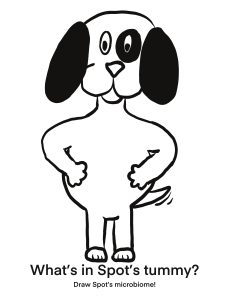24 Spot’s Tummy Trouble: Instructor guide
Rachel Cheung; Anne Freed; and Shelby Woodland
Spot’s Tummy Trouble
Instructional Guide
Learners will explore what the microbiome is and learn broadly what probiotics are. The lesson will include a short story followed by activities.
Intended Grade Level
2nd grade. Students should be able to read a short story independently. They do not need any prior knowledge of the GI system.
Learning objectives
- Students will be able to describe what the microbiome is and understand that they have one in their tummy.
- Students will be able to describe the functions of the microbiome and the role of probiotics.
Lesson Format
This can be done in any size group. The material can be printed and disseminated for story time.
- First, students will read the story together. (15 minutes)
- Then, students will draw what they think is in a dog’s tummy, including their microbiome. (25 minutes)
- The assessment will include students matching microbe characters to their jobs in a drag-and-drop fasion (5 minutes)
Lesson Background
The teacher should have a basic understanding of the microbiome, including:
- The microbiome is made up of a wide variety of microbes, including bacteria, protozoa, fungi, and viruses. While the focus of this lesson is on the microbiome of the GI system, we also have unique microbiomes on our skin and other organs. For this lesson, we refer to microbes as “bugs” to simplify the concept for students.
- The microbiome has several functions that we will review during the lesson. The functions we will review during this lesson, in more detail, include:
- The microbiome’s normal flora is responsible for preventing pathogenic organisms from entering the GI system.
- The microbiome’s normal flora nourish the gut endothelial cells and improve the mucus layer.
- The microbiome’s normal flora stimulates the immune system.
- The microbiome’s normal flora produces essential vitamins, including B1, B2, B12, and K.
- The microbiome’s normal flora act as an energy source.
Activities
Lesson: Have students read the interactive book “Spot’s Tummy Trouble” on their own. If in a group, have students take turns reading each page. This story can be found on the student page.
Coloring Activity: Print out copies of Spot’s coloring sheet (see below). Have each student draw what they think is in Spot’s tummy.

Assessment: See student page.
Common misconceptions and challenge points
We use the idea of “bugs in your gut” to simplify the idea of microbes for learners. It may be helpful to explain to students that microbes are actually living things so small you can’t see them.
Assessment
Students will drag an image of one of the microbes from the lesson and drop it in the box that is labeled with their corresponding job. This requires students to review some different jobs that microbes perform, and reminds them that microbes are helpful.
Further Exploration
Other chapters within this textbook may be interesting for students. Some options can be found linked below:

